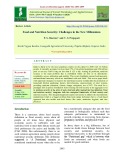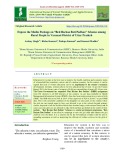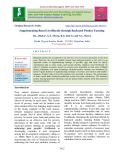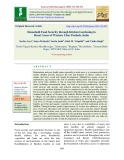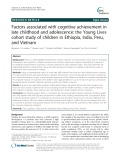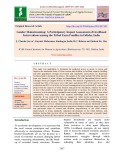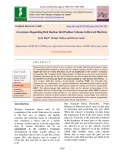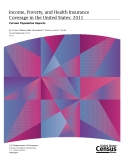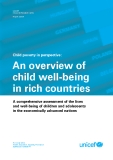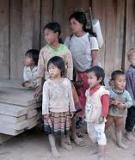
Improved household nutrition
-
This review highlights current food insecurity and nutritional insecurity which are interlinked with each other. This review paper deals with important strategies to improve the nutritional security in India like the promotion of household kitchen gardening, dietary diversification, empowerment of rural women, providing nutrition education, climate change mitigation, use of ICT.
 7p
7p  nguaconbaynhay7
nguaconbaynhay7
 15-08-2020
15-08-2020
 12
12
 1
1
 Download
Download
-
A Front Line Demonstration (FLD) on Demonstration of Nutri Farms for year round nutrition security among farm families was implemented by ICAR-Krishi Vigyan Kendra, Bagalkot for the year 2018-19 in ten women farmers fields at Sunaga village of Bilagi taluak of Bagalkot district with an objective to improve the nutritional status of people vulnerable to micronutrient malnutrition by increasing the year round supply of a diverse range of fruit and vegetables from a household-managed garden.
 6p
6p  nguaconbaynhay7
nguaconbaynhay7
 15-08-2020
15-08-2020
 13
13
 1
1
 Download
Download
-
Education for women is the best way to improve the health, nutrition and economic status of a household that constitute a micro unit of a nation economy. In this context, it can be argued that lack of women education can be an impediment to the country’s economic development. In India, women achieve far less education that of men. As per the Census Report 2011, the literacy rate of women is 65.46 per cent and that of men is 82.14 per cent. The Union Government has expanded “Beti Bachao Beti Padhao” (BBBP) programme from 161 districts to all 640 districts of the country.
 6p
6p  angicungduoc6
angicungduoc6
 22-07-2020
22-07-2020
 15
15
 2
2
 Download
Download
-
Backyard poultry has recognized as an effective tool for poverty alleviation in the rural areas. However, the level of monthly income from backyard poultry is low still it is an important source of supplementing earnings. It provides eggs and meat for family consumption and, to some extent, cash income thereby, enhances rural livelihoods.
 4p
4p  angicungduoc6
angicungduoc6
 20-07-2020
20-07-2020
 8
8
 1
1
 Download
Download
-
Goat rearing plays a prominent role in the rural economy in supplementing the income of rural household particularly the landless, marginal and small farmers. Goat is considered as poor man‟s cow and it can be profitably being reared with low investment under semiintensive as well as the extensive systems of management. They provide quick return on account of their short generation intervals, high rate of prolificacy and making the related products.
 8p
8p  quenchua6
quenchua6
 15-06-2020
15-06-2020
 18
18
 1
1
 Download
Download
-
Malnutrition and poor health status especially in rural areas is a common problem. It retards children growth, increases the risk and duration of illness, reduces work output, and slows social and mental development. Malnutrition among women of reproductive age increases the risk of mortality during labor and delivery and puts their newly born children at risk of long-term deficiencies. Improving nutritional status, including micronutrient status, can lead to increased productivity, increased child survival and growth, and reduced maternal morbidity and mortality.
 7p
7p  cothumenhmong4
cothumenhmong4
 25-03-2020
25-03-2020
 18
18
 1
1
 Download
Download
-
There is a well-established link between various measures of socioeconomic status and the schooling achievement and cognition of children. However, less is known about how cognitive development is impacted by childhood improvements in growth, a common indicator of child nutritional status.
 9p
9p  vichengshin2711
vichengshin2711
 29-02-2020
29-02-2020
 21
21
 2
2
 Download
Download
-
This study was undertaken to document the gendered access to assets, to assess and improve the nutritional status of tribal women and children, to facilitate capacity building and skill upgradation through need based and sustainable interventions for improving livelihood and to document the impact. The sample of the study include 160 tribal families from two clusters of tribal villages in Shamakhunta block in Mayurbhanj district and R. Udayagiri block of Gajapati district in Odisha.
 8p
8p  trinhthamhodang3
trinhthamhodang3
 22-02-2020
22-02-2020
 15
15
 0
0
 Download
Download
-
Education for women is the best way to improve the health, nutrition and economic status of a household that constitute a micro unit of a nation economy. In this context, it can be argued that lack of women education can be an impediment to the country‟s economic development. Mr. Narender Modi, Prime Minister of India has given stress on the need of educating and protecting the girl child. Therefore, the present study has been planned with the objectives to develop and expose the media package on “Beti Bachao Beti Padhao” to rural women.
 7p
7p  trinhthamhodang3
trinhthamhodang3
 22-02-2020
22-02-2020
 13
13
 0
0
 Download
Download
-
What have been the impacts of the GGDP-generated maize technologies? In the absence of reliable baseline data, it was not possible to calculate quantitative measures of project impact. Based on farmers’ qualitative judgments, however, it is clear that adoption of the GGDP-generated technologies has been associated with significant farm-level productivity gains (measured in terms of maize yields) and noticeable increases in the income earned from sales of maize. Impacts on the nutritional status of rural households, however, appear to have been less pronounced.
 147p
147p  loixinloi
loixinloi
 08-05-2013
08-05-2013
 81
81
 6
6
 Download
Download
-
The poultry sub-sector is crucially important in the context of agricultural growth and improvement of diets of people in Bangladesh. The sub-sector is particularly important in that it is a significant source for the supply of protein and nutrition in a household's nutritional intake. It is an attractive economic activity as well, especially to women and poor population. One of the major problems of development of the poultry sub-sector in Bangladesh relates to lack of sufficient and appropriate feeds (Mitchell 1997; Alam 1997).
 130p
130p  loginnhanh
loginnhanh
 22-04-2013
22-04-2013
 46
46
 5
5
 Download
Download
-
The Men’s Questionnaire was administered to all men age 15-59 living in every other household in the CDHS sample. The Men’s Questionnaire collected much of the same information found in the Women’s Questionnaire but was shorter because it did not contain a detailed reproductive history or questions on maternal and child health or nutrition. An instruction manual was also developed to support standardized data collection. All data collection instruments were pre-tested in June-July, 2010.
 89p
89p  nhamnhiqa
nhamnhiqa
 01-03-2013
01-03-2013
 63
63
 2
2
 Download
Download
-
The U.S. postal savings system had a later start than most, as well as an earlier end. Advocates, from the 1870s on, had cited the success of postal banks in most of the leading countries of the world in arguing for such a system to encourage household saving in the United States. 5 But commercial bankers successfully opposed this as an unnecessary incursion into the province of private business, until the banking panic of 1907-1908 brought the issue of safe banking facilities for ordinary people to national prominence.
 114p
114p  bi_ve_sau
bi_ve_sau
 17-01-2013
17-01-2013
 55
55
 2
2
 Download
Download
-
One of the most important indicators of socioeconomic development in a country is the educational level of its population. Moreover, education, especially for women, is closely linked to a number of demographic and health outcomes for which trends are examined in this report, including fertility, contraceptive use, and health and nutritional status of mothers and children. Figure 2.4 shows substantial improvement in household educational attainment in the past ten years.
 34p
34p  thankinhphanliet
thankinhphanliet
 21-12-2012
21-12-2012
 43
43
 3
3
 Download
Download
-
The Working Group recommends that, as industry develops new products and reformulates existing products, it should strive to create foods that meet both of these two basic nutrition principles. It further recommends that industry focus these efforts on those categories of foods that are most heavily marketed directly to children, such as breakfast cereals, carbonated beverages, restaurant foods and snack foods.
 29p
29p  connicquy
connicquy
 14-12-2012
14-12-2012
 45
45
 2
2
 Download
Download
-
Conditional transfer programs have been shown to improve child health. PROGRESA, for instance, where nutritional supplements were linked to the participation in various educational programs, has had a significant impact on increasing child growth and in reducing the probability of child stunting. However, it is unclear if this improvement is because more resources are available to the household, or because the program improves the access of the household to health care facilities (Skoufias, 2001).
 52p
52p  can_thai
can_thai
 12-12-2012
12-12-2012
 40
40
 2
2
 Download
Download
-
The purpose of this paper is to understand the determinants of child health. In particular, we will focus on the influence of household consumption and public infrastructure on child health. This would inform policy makers when setting priorities among different interventions. It is important to understand whether different policies are substitutes or complements. Poverty and low education could cause bottlenecks, not allowing other public policies to influence child health.
 80p
80p  can_thai
can_thai
 12-12-2012
12-12-2012
 52
52
 1
1
 Download
Download
-
In 2004, the Child Survival Partnership, with support from the Ethiopian government, held the National Partnership Conference on Scaling Up Child Survival Interventions. Participants at the conference agreed to develop a single plan for improving child survival in Ethiopia, double resources for health in Ethiopia, and support the new Health Service Extension Package. The Addis Ababa Statement, developed by the Healthy Newborn Partnership, was also presented at the conference.
 14p
14p  connhobinh
connhobinh
 10-12-2012
10-12-2012
 48
48
 1
1
 Download
Download
CHỦ ĐỀ BẠN MUỐN TÌM









